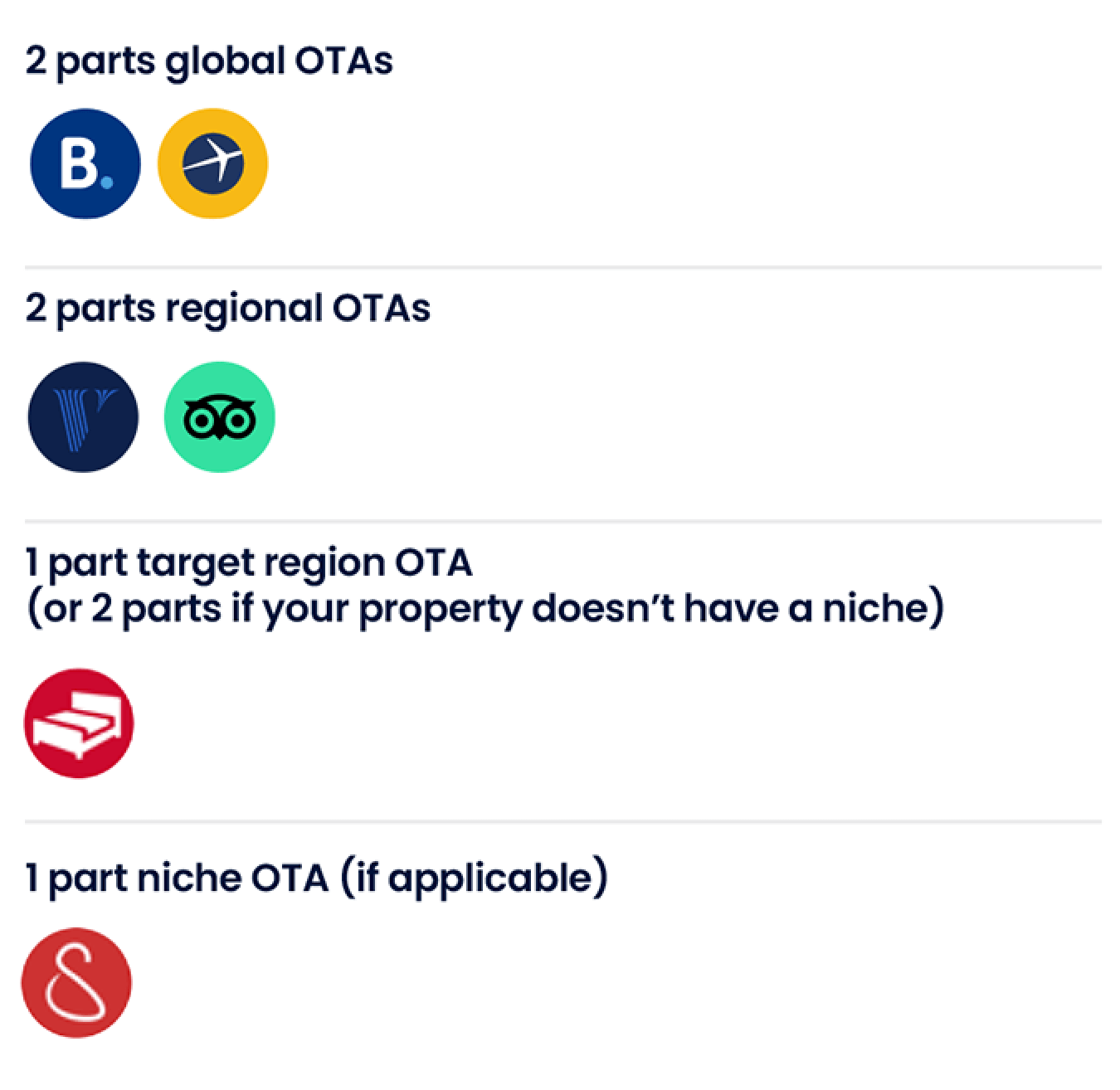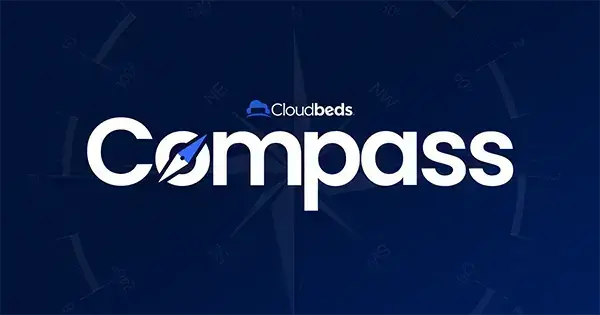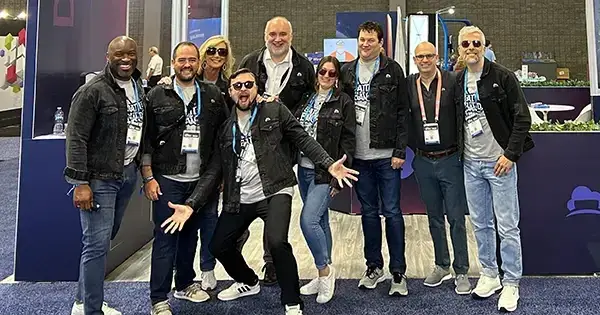The billboard effect: 10
strategies to build your channel mix
Travelers in the planning phase of their trip will often run into the same properties repeatedly when searching across different online travel agencies. Expedia Group found in its 2023 report that the average trip consideration window is 71 days, with 33 days in the inspiration phase and 38 days in the research and planning phase. During the early stages of planning, travelers average around 2.5 page views per day, but in the days before a booking, page views increase exponentially, with 25 page views on the day of purchase
During this long booking process, travelers often go directly to a property’s website to find out more information, especially if they’ve seen the same property on multiple OTAs.
This phenomenon is called “The Billboard Effect” and was introduced by Chris Anderson, Associate Professor at Cornell University, in 2009. This Cornell study found that hotels listed on OTAs experience a boost in direct hotel bookings due to their presence on OTA websites.
More recently, Anderson released a follow-up study in 2017 titled ‘The Billboard Effect: Still Alive and Well’ and found that while the demand funnel is more complex today with the multitude of marketing efforts such as SEO and SEM, 30% of direct bookers still start their research process at an OTA.
During Passport 2024, Ben Lloyd, Director of Digital Marketing Services at Cloudbeds, shared how the Billboard Effect can help lodging businesses build a stronger online presence and open themselves up for more direct bookings.
Advantages of the billboard effect
The number one advantage of the billboard effect in the hospitality industry is getting more visibility on your property, more visitors to your website, and more direct bookings.
By having multiple OTA listings, you increase the chances of being noticed by travelers and having them visit your own website to learn more and book direct.
Listings on popular global OTAs will ensure a steady volume of traffic to your site, increasing the opportunity for direct bookings, and niche OTAs will help drive more qualified traffic to your website with a higher likelihood of conversion. Therefore, developing a channel mix that fits your audience and property will be pivotal in maximizing the billboard effect.
What is a channel mix?
A channel mix is the selection of travel sites that a property connects to with the goal of gaining increased visibility across its target audience. With hundreds of online channels today, properties that want to build an effective distribution strategy should prioritize those that align with their hotel brand and attract visitors they‘ve identified as their target market.
Choosing the right online travel agents for your channel mix can help your property get exposure across different regions and audiences to increase occupancy rates without additional marketing spend. Also, OTA sites often include currency conversions, language support, and tailored experiences based on purchasing habits that help convert travelers on a global scale. It would be difficult to repeat these features and marketing tactics on your website without spending a large budget on marketing.
How to build the optimal channel mix
Building a robust channel mix that consists of a wide variety of OTAs is critical to driving more reservations and hotel revenue. Your mix should include a selection of OTAs from the following categories:
Global OTAs
Major, global OTAs like Expedia, Booking.com, and Tripadvisor should be the foundation of your channel mix. They attract hundreds of millions of visitors each month, making them a critical channel to promote your property. However, these sites have millions of listings and charge up to 30% commission rates, so they should not be the only channels you depend on.
Regional OTAs
Regional OTAs help attract domestic travelers and those from specific countries. For example, while Agoda is not a popular booking site in Mexico, Mexican properties can list their property to attract visitors from Asia and the UK, where it is a very popular OTA. Regional OTAs can be especially useful for filling demand during your off-seasons when travelers in the opposite hemisphere prepare to travel during their seasonal break.
Niche OTAs
One of the most lucrative strategies for your channel mix is to include niche channels that target particular audiences. Niche OTAs today include surf or ski properties, camping or glamping properties, luxury or boutique properties, and more. Travelers who visit these sites have very specific desires, and if they find a property that meets their needs, they are more likely to be repeat guests.
The (channel) recipe for success
Different OTAs cater to different property types and audiences, making it essential to understand your target audiences and your unique market position before choosing your channels. The optimal channel mix won’t be the same for every property, so we’ve developed a recipe for success to help properties build their distribution strategy.

To increase visibility to potential guests, property owners should be connected to 6 OTAs, incorporating 2 global OTAs, 2 local OTAs (active in your region), 1 target region OTA (targeting travelers from a different regional market), and 1 niche OTA (if applicable).

For example, a luxury boutique hotel in Mexico may decide to list its property on the following channels:
- Booking.com / Expedia (Global)
- Airbnb(Global)
- Despegar/Decolar (Regional to Mexico)
- Agoda/Trip.com (Targeting Asia)
- Mr & Mrs Smith (Niche – luxury OTA)
This comprehensive channel mix helps hoteliers reach their target guest demographic to increase occupancy and drive traffic to their hotel website, where their final booking decision will be made.
10 tips for building your ideal channel mix
1. Include your go-tos
As part of your mix, choose OTAs that you’re familiar with and you know deliver results. As you add new channels, ensure you properly optimize your property’s OTA profile so you can improve your listing rank on their website and gain more visibility.
2. Consider alternative channels such as bed banks
A bed bank is an alternative wholesale channel in the travel industry for properties to leverage as part of their channel mix. As group and business travel picks up in the next year, bed banks will be an even more important distribution channel. Bed banks purchase rooms from properties, typically in bulk and for specific dates, at discounted rates and resell them to OTAs, airlines, and travel agents. Hotelbeds is one of the largest wholesalers, with 71,000 travel distributors (up 10,000 from last year) in 150 destinations.
3. Familiarize yourself with OTA business models
The two main business models that OTA providers use today are the agency model and the merchant model. Under the agency model, OTAs act as an agent, passing reservations booked by customers to hotels and receiving a commission in return. Commissions can either be paid at the time of booking or after an agreed-upon time period (ie. after the check-out month).
The merchant model is another common business model. Under merchant models, hotels sell rooms at wholesale prices to OTAs, and from there, OTAs are responsible for setting room rates and selling to customers. Booking.com recently moved away from an agency model towards a merchant model, reaching 60% of global adoption in 2022.
A third model, advertising, has increased in popularity and exists on metasearch sites. Metasearch engines work primarily on a cost-per-click basis where hotels can promote their rooms with links to their direct booking engine and pay a fee based on the number of clicks they receive. Some of these sites, such as Google, also offer a cost-per-acquisition model (also known as “pay per stay”) where the property pays a percentage of the total reservation cost upon completion of the stay.
4. Analyze fees and commission rates
All OTAs charge different fees and commission rates depending on their business models. When building out your channel mix, it’s important to identify the fees per channel and the value your property gains from each. Commission rates have grown steadily over the years, with most today ranging between 15% and 30%. Keep in mind that there is room for negotiation when finalizing your contract with OTAs, so be sure to push to get the lowest rate possible for your property type.
It’s good practice to include a combination of OTAs with differing commission structures to get the most visibility for your property while limiting spend.
5. Look at where your competitors are listed
It’s essential to be active on channels where your competitors are listed, not only so you can keep a competitive edge but also because these OTAs are likely the best channels to encounter your target audience. However, it’s also important to identify channels undiscovered by your competition where you can be first to market. Consider targeting a new region to drive new guest demographics to your property.
6. Measure your results and refine
Continually review your channel mix and make changes over time to keep your content fresh and relevant. See which channels are bringing in the most reservations and evaluate if the commission costs are within a reasonable rate for your revenue management strategy. Once you get more comfortable managing your channel mix, you can experiment with adding different OTAs or adjusting how you distribute your inventory.
7. Manage reviews
Naturally, as you increase the number of channels your property is connected to, you’ll also collect more reviews. Positive online reviews are one of the best tools to convert travelers into guests. On the other hand, poor reviews can negatively impact your business. Therefore, you should develop a strategy to manage your online reputation. Sending out post-stay surveys to gauge guest satisfaction can allow you to identify and resolve issues before they become bad reviews and also help you recognize guests willing to leave you a positive review.
8. Don’t forget about your social channels
Your social media profiles serve as an extension of the billboard effect since many travelers use social media as a search engine (especially TikTok and Instagram). Understand what social media sites your target audience frequents and actively engages on these channels. By showcasing your property on social media through videos, high-quality pictures, and reviews, you can establish trust and encourage users to book direct.
9. Have a user-friendly website
Driving traffic to your website is only half the battle. Ensure that your website is easy to navigate and mobile-responsive for a seamless user experience. A modern design that matches your brand and clear calls to action can help direct users to book.
10. Invest in a channel manager
A channel manager is essential for managing multiple OTAs so you can keep track of your rates and availability in real-time while avoiding unintentional overbookings. Look for a channel manager that’s integrated with your property management system (PMS) to facilitate a more seamless online booking experience.

















